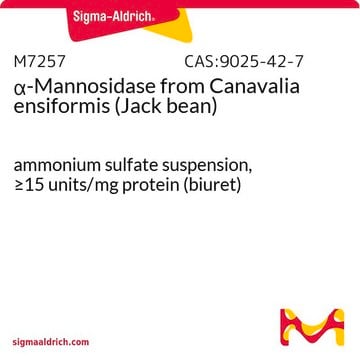G7673
α-Galactosidase I, Alkaline from Cucumis melo
Sinónimos:
α-D-Galactoside Galactohydrolase, Melibiase
About This Item
Productos recomendados
recombinante
expressed in E. coli
Ensayo
≥85% (SDS-PAGE)
Formulario
lyophilized solid
actividad específica
≥20 units/mg protein
mol peso
apparent mol wt ~84 kDa by SDS-PAGE
Condiciones de envío
wet ice
temp. de almacenamiento
−20°C
Descripción general
Aplicación
Acciones bioquímicas o fisiológicas
Propiedades físicas
Definición de unidad
Forma física
Palabra de señalización
Warning
Frases de peligro
Consejos de prudencia
Clasificaciones de peligro
Eye Irrit. 2 - Skin Irrit. 2 - STOT SE 3
Órganos de actuación
Respiratory system
Código de clase de almacenamiento
11 - Combustible Solids
Clase de riesgo para el agua (WGK)
WGK 3
Punto de inflamabilidad (°F)
Not applicable
Punto de inflamabilidad (°C)
Not applicable
Elija entre una de las versiones más recientes:
Certificados de análisis (COA)
¿No ve la versión correcta?
Si necesita una versión concreta, puede buscar un certificado específico por el número de lote.
¿Ya tiene este producto?
Encuentre la documentación para los productos que ha comprado recientemente en la Biblioteca de documentos.
Filtros activos
Nuestro equipo de científicos tiene experiencia en todas las áreas de investigación: Ciencias de la vida, Ciencia de los materiales, Síntesis química, Cromatografía, Analítica y muchas otras.
Póngase en contacto con el Servicio técnico








